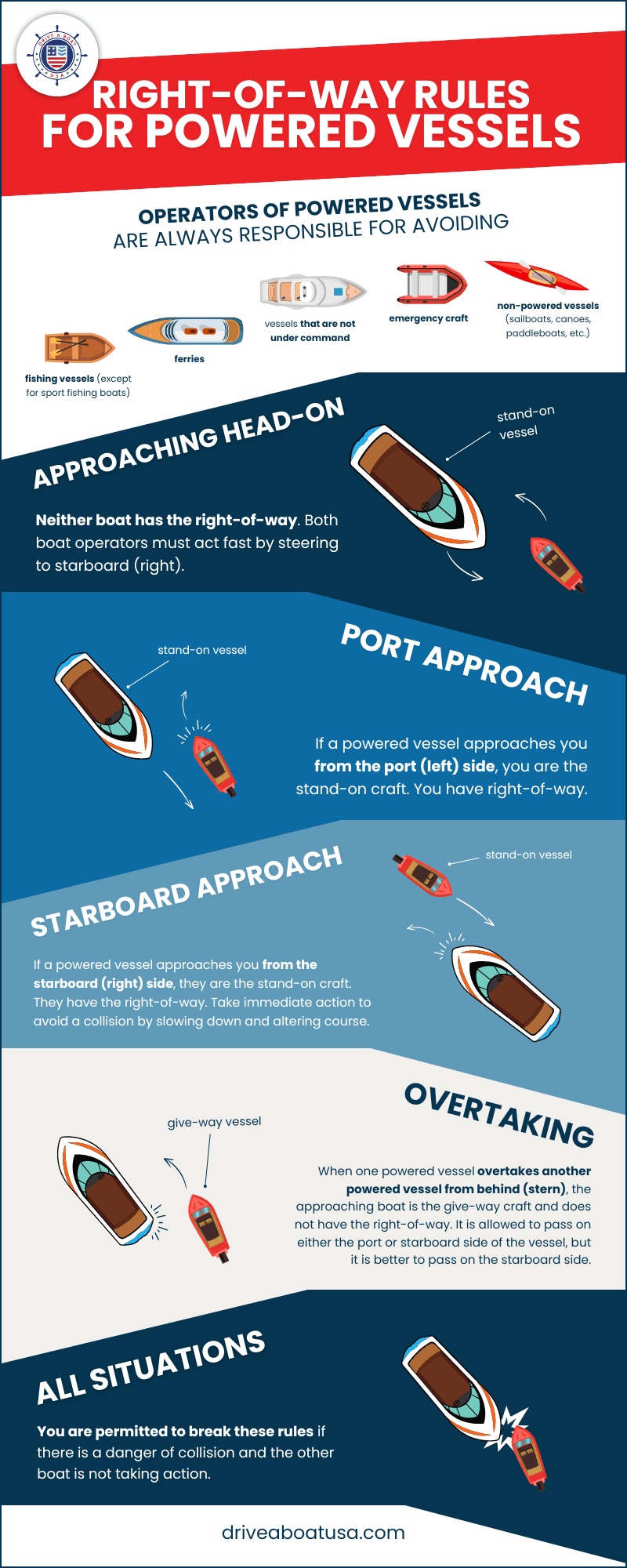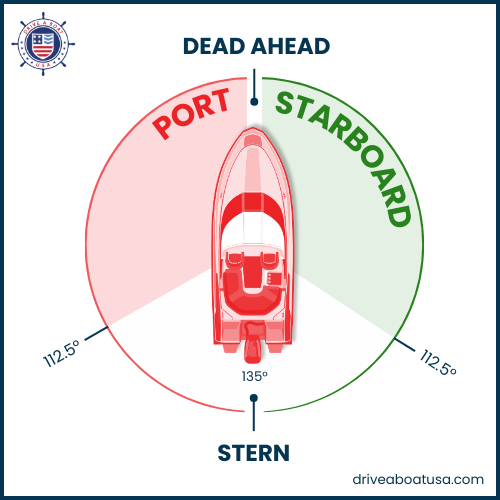Boat Right of Way Rules and Power-Driven Vessel Path Crossing
Safe boating involves knowing the rules of navigation by heart. When you’re approaching another boat, or another boat is approaching you, there’s no time to check your rulebook! Keep reading to learn the rules of right-of-way for power-driven pleasure craft.
Important terms for understanding right-of-way
First, get to know the difference between port and starboard.
Stand-on craft refers to the boat that has the right-of-way. This boat can continue in the same direction and at the same speed.
Give-way craft refers to the boat that does not have the right-of-way. This boat is responsible for changing course and speed in order to steer clear of the stand-on craft.
The sectors of navigation are the port sector, starboard sector and stern sector. You can refer to these to figure out each boat’s position relative to the other.
Factors influencing which vessel has right-of-way
When operating a powered vessel, the main factors influencing who has right of way are:
- The type of watercraft you’re approaching
- The position and direction from which other craft are approaching
- The type of waterway you’re on.
Note that emergency craft always have the right-of-way. Power vessels are responsible for steering clear and yielding to all types of search and rescue watercraft.
You are also responsible for avoiding fishing vessels (except for sport fishing boats), ferries, vessels that are not under command, and non-powered vessels (sailboats, canoes, paddleboats, etc.)
All motorized boats under 20m in length must steer clear of larger vessels that cannot be so easily maneuvered. Operators of personal watercraft (PWC) are responsible for following the same rules for steering clear of other vessels as other motorized pleasure craft.
Powered vessels: who has the right of way?
If you are operating a powered pleasure craft, these are the rules you need to follow to avoid collisions out on the water:
Approaching head-on
When power-driven boats approach each other head-on, neither boat has the right-of-way. Both boat operators must act fast by steering to starboard (right).
Port approach
If a powered vessel approaches you from the port (left) side, you are the stand-on craft. This means you have right-of-way, so you can continue in the same direction at the same speed. Stay alert and be ready to adjust as needed.
If you are approaching another vessel from the port (left) side, you are the give-way craft. This means you have to act fast to avoid a collision by slowing down and altering course.
Starboard approach
If a powered vessel approaches you from the starboard (right) side, they have the right-of-way.
You are the give-way craft. This means you do not have right-of-way. Take immediate action to avoid a collision by slowing down and altering course.
If you are approaching another vessel from the starboard (right) side, you are the stand-on craft. This means you have right-of-way, so you can continue in the same direction at the same speed. Stay alert and be ready to adjust as needed.
If you are the stand-on vessel, and you observe that the give-way vessel is not taking appropriate action to avoid collision, you should break the rules and take evasive action.
Overtaking
When one powered vessel overtakes another powered vessel from behind (stern), the approaching boat is the give-way craft and does not have the right-of-way. The boat operator must adjust speed and course to immediately steer to a safe distance from the boat ahead. You are allowed to pass on either the port or starboard side of the vessel, but it is better to pass on the starboard side.
Sound signals for navigation
Sound signals can help communicate your intended manoeuvres to other boat operators.
One short blast: I’m changing course to starboard (right).
Two short blasts: I’m changing course to port (left).
Three short blasts: I’m reversing my boat.
Five quick blasts: I’m uncertain about the other boater’s intentions.
One long blast: I’m a motorized boat of 12 meters or longer and I’m leaving the dock.
Exceptions to following the rules for right-of-way
All boat operators must adhere to right-of way navigation rules at all times. The only permissible exception to these rules is if you need to break a rule to prevent a collision or some other immediate danger. You will be held accountable for your actions in the case of a boating accident.
As a boat operator, you are responsible for assessing the risk of collision. If you are unsure, assume that a risk does exist and act accordingly, taking every safety precaution in addition to changing course. Keep the necessary safety equipment on board, always be prepared for the possibility of cold water immersion and be sure all crew are wearing approved life jackets, including children.
Learn the rules of navigation and get your boating license from Drive A Boat USA
Driving a boat means being responsible for the safety of everyone on board. There is no better way to get prepared than to take a safe boating exam and get your state-specific boating license.
With our online course, you can learn about downstream and upstream, navigation lights, water skiing hand signals, and more. Following a boater safety course is a great way to learn what you need to know to enjoy water sports without mishaps. Boaters in New York, California and Florida can earn a NASBLA and U.S. Coast Guard approved license online now from Drive A Boat USA!



